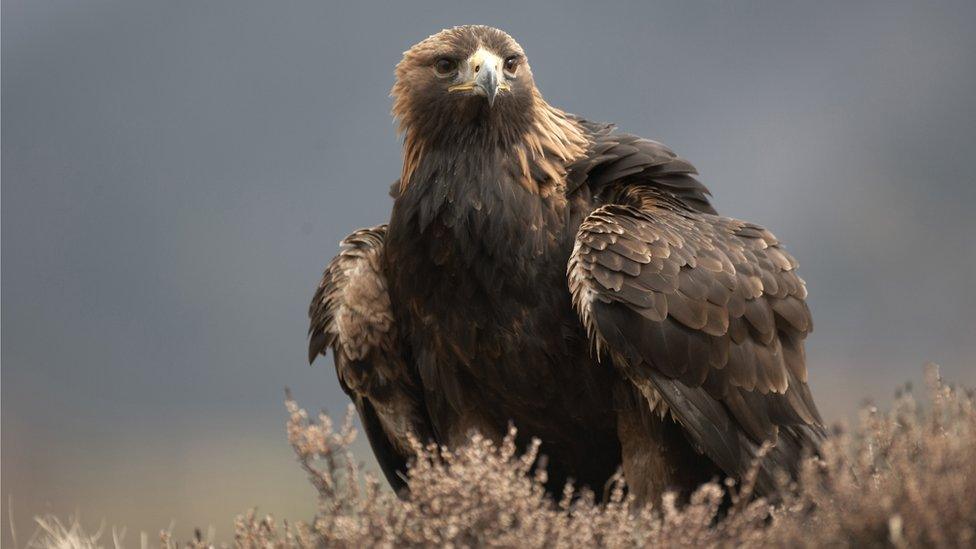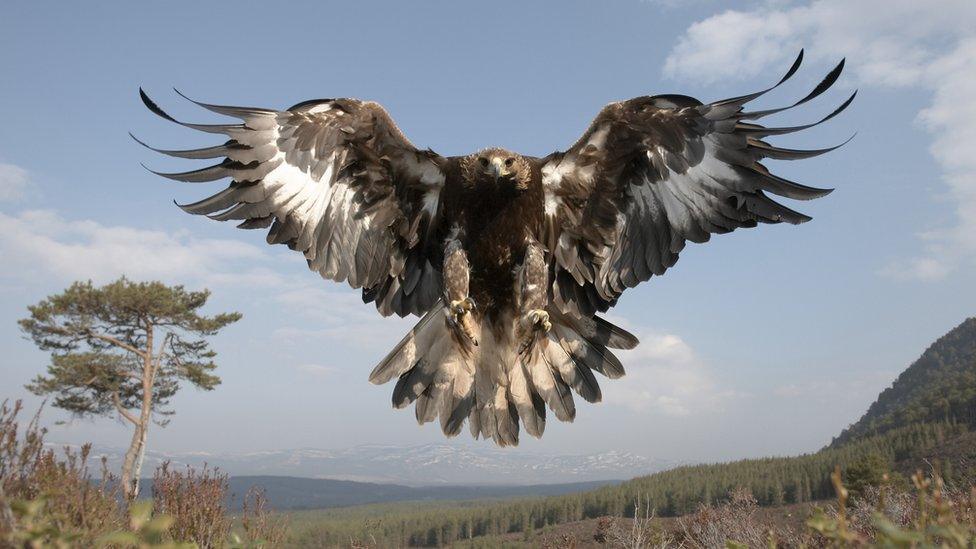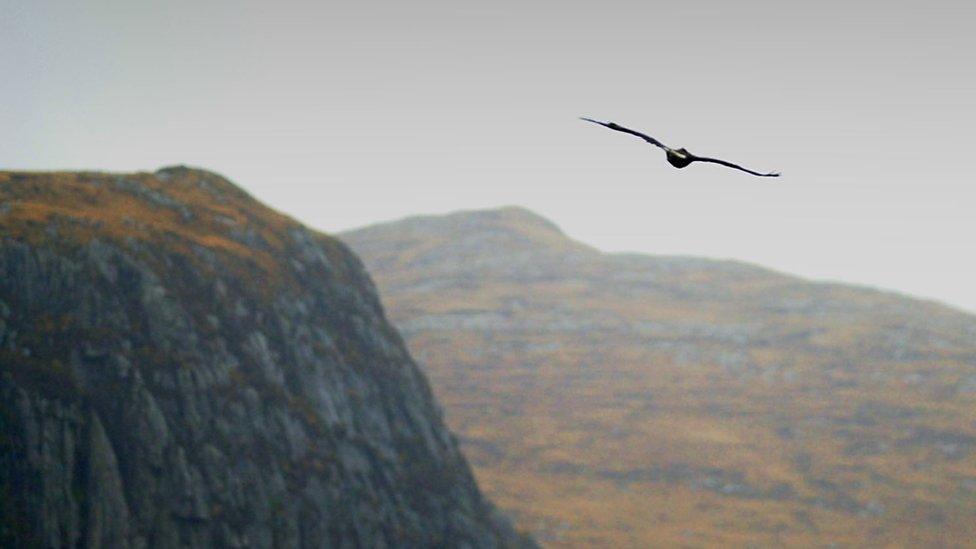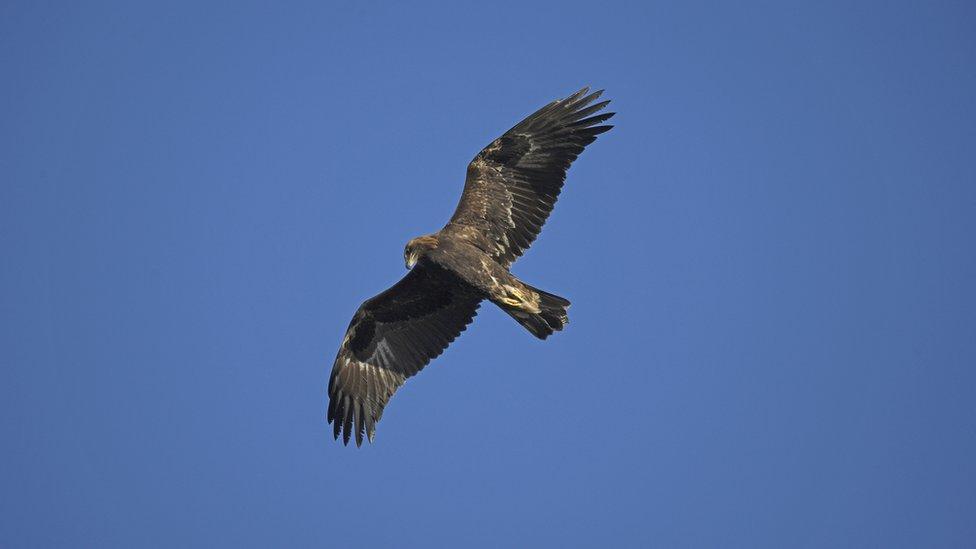Golden eagle numbers close to 'historic' levels
- Published
- comments

Scotland is now thought to be home to the UK's entire population of golden eagles
Numbers of golden eagles in Scotland are close to "historic" levels, with more than 500 pairs, a survey of the birds has found.
RSPB Scotland said there had been a 15% rise since 2003, when the last survey took place, from 442 to 508 pairs.
The research was carried out by experts from the wildlife charity and the Scottish Raptor Study Group.
Scotland is now thought to be home to the UK's entire population of golden eagles.
England's only resident golden eagle, which occupied a site near Haweswater in the Lake District, has not been seen for more than a year and is feared dead.
The RSPB said the six-month survey - which the charity co-funded with Scottish Natural Heritage (SNH) - showed the raptor could now be defined as having a "favourable conservation status".
'Awe-inspiring'
Numbers of golden eagles in Scotland reached very low numbers in the mid-19th Century, but have been steadily recovering since then.
Duncan Orr-Ewing, head of species and land management at RSPB Scotland, said the birds were an "awe-inspiring part of our natural heritage" and welcomed the news from the survey.
"Across many parts of Scotland there's been a very welcome turnaround in how people respect these magnificent birds, part of a more enlightened public attitude towards birds of prey," he said.
"Increased monitoring and satellite tagging of eagles, as well as stronger sanctions against wildlife crime may be serving as effective deterrents against illegal activity, therefore helping their population to increase.
"However, the continued absence of golden eagles in some areas of eastern Scotland remains a real cause for concern and suggests that much more work needs to be done."

The six-month survey in 2015 was carried out by bird and conservation experts
The northern Highlands and the area between the Great Glen and Stirling saw the greatest increase in numbers between 2003 and 2015, when this latest survey was carried out.
Recovery also continues in much of the west Highlands and islands.
However, the population west of Inverness remained stable over the past 13 years rather than grew.
The RSPB said the reason behind the lack of recovery in that area was not clear, but pointed to persecution, recreation, forestry and poor weather as possible factors.
A decline in the number of animals that eagles eat because of grazing pressure from deer is thought to be another possible cause.
The survey also found golden eagles were not found at all in many parts of the eastern Highlands, with less than a third of these traditional "home ranges" occupied by a pair, despite being a "very productive landscapes" for these birds.
The RSPB blamed the raptor's absence from these areas on persecution and said four eagles fitted with satellite tags had been found illegally killed in the central and eastern Highlands between 2009 and 2013.
And in August, it emerged that eight golden eagles had vanished in the Monadhliath mountains, south-east of Inverness, in less than five years.

The golden eagle now has a favourable conservation status in Scotland
The RSPB claimed they had been illegally killed and their satellite tags destroyed, but the Scottish Moorland Group said there was no evidence to support this.
The Scottish government is carrying out a review into the disappearances, which it called "disturbing and disappointing".
Environment Secretary Roseanna Cunningham added: "The golden eagle is a magnificent bird and it is extremely heartening to see a rise in the number of this iconic species in our skies. The successes have been down to partnership work and this is continuing with the South of Scotland Golden Eagle project, which aims to boost populations even further.
"But it is clear from this national survey that there are still areas of Scotland, which are ideal habitats for golden eagles to breed and hunt, where there has not been a recovery in population despite a lot of hard work to protect these birds. This seems like a missed opportunity."
Uneven picture
Andrew Bachell, SNH's director of policy and advice, said: "It's wonderful to see golden eagles reaching favourable conservation status nationally. These beautiful birds are such an important part of Scotland's nature, a species which people love to see when they visit our wilder landscapes.
"It's particularly encouraging to see greater recovery in some areas where persecution had been thought to be a major constraint in the past. That picture is uneven though, and we would still expect eagles to be doing better in parts of the eastern Highlands."
Tim Baynes, director of the Scottish Moorland Group at Scottish Land and Estates, said the increase in the golden eagle population was "in large part" a tribute to members of the group and the way they managed the land.
"They have helped the surveyors and worked with Scottish Natural Heritage in the interest of golden eagles for many years," he said.
"The east Highlands still have the highest level of productivity (young per pair) and a stable number of occupied territories over more than three decades.
"The south central Highlands, which includes significant areas of driven grouse moor has shown by far the greatest increase in range occupancy - 70% - since 2003."
- Published14 April 2016

- Published13 February 2015

- Published14 August 2015
